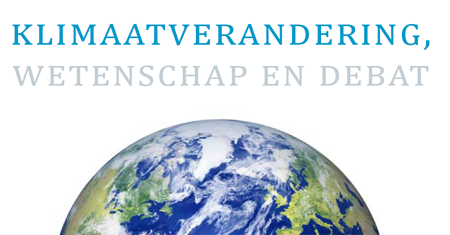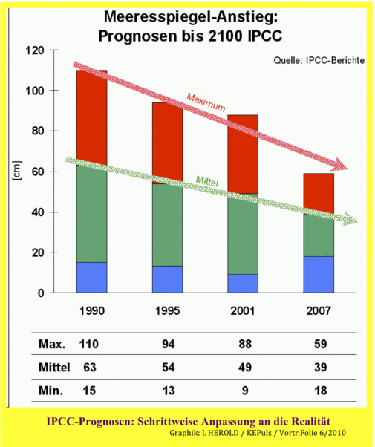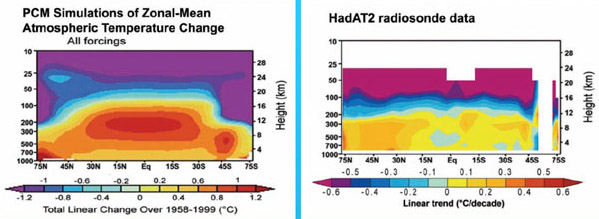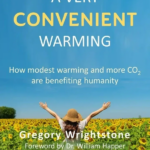(English version of this blog in Dutch, with credits to Albert Jacobs for the initial translation)
Last week the Dutch academic counsel presented a report to the Dutch parliament, stating that it contained impartial, detailed, scientific and accurate information about the present state of climate science. In reality the report portrayed the IPCC claims als being scientifically proven, and did so embedded in a tsunami of scientific errors.
I will discuss the most striking ones.
The hard facts
The premise of the brochure is clear:
(P. 8 ) …. With this brochure the Academy, as an “honest broker” in knowledge, wants to give you as reliable a picture as possible of the situation on climate change. What do we know, and how sure are we of that? Where are the real controversies, and why are they there? ….
This brochure puts the scientific, “hard” facts about our climate in a row, and highlights the controversies and uncertainties in climate research at issue which you also encounter in the media. ….
The final section contains seven related propositions on climate change – issues which science agrees on.
So, the authors claim to present hard, scientifically proven conclusions. But this claim does not hold.
The brochure
1. It is a report from 2010, which has not been updated. It shows the situation at more than a year ago, but that is not mentioned anywhere. This is misleading.
2. (P. 10) “The purpose here (the IAC examination of IPCC after climategate, TW) was the question whether errors were made that affect conclusions of the IPCC;”
This was certainly not the purpose of the research. That was even intentionally restricted to a small part of the IPCC report, and thus excluded the overall conclusions. Yet immediately after the study it was concluded that the IPCC claims remained unaffected. Also in this report it was suggested that the investigations exonerated the conclusions of the IPCC. They’ve never done that. They showed that there were many things wrong in the set-up, working methods and transparency of the IPCC. It can therefore be concluded that the final conclusions may not necessarily remain unaffected without further investigation. But the IAC and the Dutch Academy have never insisted on such examination of the main conclusions of the IPCC.
3. (Page 12) “The IPCC tries to finally get a coherent report through a multi-stage editing process, where all comments and criticism – and how they have been acted upon – are kept and published.”
Here the report puts much emphasis on the peer review process within the IPCC, as if it were identical (almost even better it appears) to the peer review process in general science. But the IPCC review process has nothing to do with the usual process in science periodicals. Normally, if your article is criticized by your peers, you are expected to radically adapt it until there is agreement, otherwise you will not get it published. But in the IPCC, an author can simply disregard the criticism by the reviewers. This is done so often that critical climate scientists no longer consider lending themselves to this sham process.
The way in which the two review processes are associated in the brochure is in my eyes very doubtful. By the way, since the writers give so much prominence to the peer-review process, I may write a request to the Academy to send me the documents about this brochure, as it was also produced through peer review, according to the writers.
4. (P. 17) “So the carbon dioxide from fossil fuels can clearly be identified.”
I do not think that’s correct . There is indeed a method that – by measuring the carbon isotope ratio in CO2 in the atmosphere – can determine that the increase of CO2 is consistent with the burning of fossil fuels, but that claim remains ambiguous and is far from waterproof.
This is of course a nonsense discussion, since we know very precisely how much CO2 we emit.
But a molecule of CO2 from fossil fuel just cannot be identified as such, and, without additional evidence, the often cited study on this topic does not say anything scientifically about fossil fuels.
5. (Pp. 18, 24, 30) “Of course, we should not forget that there are indeed facts that we cannot ignore, such as rapidly rising carbon dioxide content of the atmosphere and, globally, rising average temperatures.”
The brochure discusses the simultaneous occurrence of warming and increased CO2 concentration several times. Regarding temperature rise, reference is made to the last 40 or 50 years, the period in which our CO2 production increased rapidly. To constantly suggest that a causal relationship exists is not scientific, but choosing the period of 50 years of temperature rise in a period of 100 years is downright tendentious. We know that the temperature started to rise after 1900 and that it cooled between ’45 and ’75. To select those last 50 years and to correlate that with CO2 concentration is unscientific and misleading: the rise between 1910 and 1945 was probably faster than that of the last 50 years, in which CO2 could possibly play a role.
6. (P. 19) “sea level rise over the past century, partly due to climate change, was about 17 cm”
Here it is suggested that this increase is due to recent climate change, attributed to human CO2 emissions. But that is certainly not a scientific fact. First, sea level rise for 12 of the mentioned 17 cm is due to the thermal expansion of the oceans after the last ice age, and this expansion is independent of the recent warming. Even the remaining 5 cm may still be the result of the warming after the last ice age: after all, the sea level rise has for centuries been on average around 19 cm.
In addition, global warming may just as well lead to a decrease in sea level rise as to an increase thereof: warmer air causes more precipitation and results in more permanent snow on Greenland and Antarctica, as I explained in this blog (in Dutch). So it is no surprise that all predictions of sea level rise of the IPCC until now, have a range, with the lower value representing a decrease of sea level rise as a result of increasing temperature. It is therefore scientifically impossible to determine whether sea level rise in the last century is partly due to recent warming, and therefore the Academy can not just claim that it is.

Lower values of IPCC predictions represent a decrease of sea level rise compared to present 19 cm, as a result of increasing temperature
8. (P. 25) “When researchers started to measure temperatures at high altitudes in the atmosphere, they saw to their surprise that they did not correspond to expectations. If the lower parts of the atmosphere are warming, it must be cooling in the upper atmosphere, the stratosphere. Satellite measurements showed the opposite: either the theory did not fit, or the measurements were incorrect. The latter proved to be the case. When data were better studied and a number of errors were taken out of the processing, the expected impact was shown to exist. Not quite – the temperature trends in the tropics are still not fully explained – but most uncertainties have disappeared: it is actually cooler in the stratosphere. “
This may be a strange way to refer to the missing hot spot. If so (although a problem with a cold spot seems to be the topic here) the scientific status of the data and the scientific discussion are clearly misrepresented. The outcome of the models is not just slightly different, but even contrary to all observations, and has been for 15 years. But if the hot spot has not been measured for all these 15 years and you keep saying that you “still cannot fully explain” this, isn’t it high time to conclude that your models are defective?
9. (P. 28) “The IPCC inadvertently drew much attention to the glaciers by a curious mistake in its latest weekly report on the impacts of climate change of 2007: instead of writing that all glaciers in the Himalayas would have disappeared in 2350, it said 2035: The mistake was overlooked by all researchers and editors, but it was not denied that it was a mistake, and the IPCC was unable to quickly calm the publicity storm that resulted. “
I do not know what I find more disturbing: the fact that this is not true (the error had nothing to do with 2350 and was not a typo), or the fact that none of the writers apparently has taken the trouble to read “The State of the Climate” by Marcel Crok, the masterpiece about the climate debate, scrutinising the IPCC’s scientific pretentions (not yet available in English). If they had, this mistake (and many others for that matter) could have been avoided.
10. (P. 28) “Just because the sun and the variations in solar activity are not well understood, some attribute great effects to them – thereby correspondingly diminishing the role of greenhouse gases.”
This is a strange remark. The reason that skeptics consider the sun and the cosmos, is because at all time scales stunning correlations between solar activity and cosmic rays and climate occur, while a causal link from CO2 to climate can not be proven anywhere in history.
11. (P. 28) “It is even possible, according to some researchers, that solar activity will decrease in the coming years to the extent that the earth’s temperature will drop. But even if the influence of the sun is not yet fully determined – all sorts of possible feedback mechanisms have still not been fully explored – in climate models that take account of the Sun, that influence appears to be small. There is speculation about other ways the sun could play significant role, but so far no convincing mechanism has emerged.”
Here, it is concealed that in the models only the direct effect of varying heat radiation from the sun is included. No skeptic claims that the influence of the sun operates in that way . The IPCC itself testifies to having very little understanding of the influences of the sun and thus has hardly shown any in its models. This sentence in the brochure suggests that we are to go along with the IPCC, until we know more about the influence of the Sun. But the IPCC is not looking for that at all. They focus on the impact of CO2.
12. (Page 29) “Again, the influence of the Sun may well complicate matters, but does not undermine the possible consequences of the enhanced greenhouse Effect.
If the sun and not CO2 concentration is responsible for the temperature rise, there is no enhanced greenhouse effect. So the question of the cause of the striking correlation between solar activity and temperature is indeed crucial for an assessment of the greenhouse effect.
13. (Page 31) “Surely, the matter is complex, but so far the observed changes are so obvious and the possible consequences can be so large that there is every reason to take the phenomena seriously. It would certainly be unwise policy to act as if there were no problem, or as if the problem would disappear by itself, or as if eventually a solution will emerge all by itself . It is better to opt for a ‘no regrets policy “: a policy that if it would be found to have been wrong, it could without much effort be reversed in a way that can be justified on the basis of benefit outside the scope of the climate.”
What this position has to do with determining what exists in hard, established science facts utterly escapes me. As it does with respect to relevance to an objective position of the Academy in the debate.
14. (P. 31) Even if climate change turns out milder than expected, it is still prudent, in the context of other considerations such as concerns about future energy and sustainable development, (1) to take the expectations in the IPCC reports into account in climate change policy. But the Academy considers such “no regrets policy” a very minimal one. Not only because the discussion, in effect, would move to the question of what measures would be a part of that policy, but also because the policies would be reduced to a regional and national problem, while an international, concerted effort is needed (2) . There still are relatively simple policy options available (3) to slow eventual global warming (4) and to reduce its effects (5). As part of this brochure it would carry us too far to give an extensive list of suggestions of all the benefits and the disadvantages, but one could possibly point to continuing research aimed at promoting the use of non-fossil fuels and materials, increasing the efficiency of energy, developing cleaner production processes, expanding the market for greenhouse gas emission allowances (6) and collecting carbon dioxide in particular, by increasing the amount of vegetation on earth.”
By all means, go ahead! The Academy is now converted into an oracle which could teach the Pythia of Delphi a thing or two. The whole litany of hope of the alarmist world in a few sentences. But none of the six claims I have highlighted here, has ever been proven scientifically.
Claim 3 is particularly astonishing: in my articles on the world energy supply in 2050 and the strictly illusive character of a global CO2 reduction due to developments in Asia, I show that there is just no option to prevent the ongoing increase of CO2 emissions. And I am supported by none other than the IPCC’s own China expert Mark Jaccard.
Even co-author of the brochure, Henk Opschoor, agreed last week in a meeting about the transition to a renewable energy supply, that a drastic innovation is needed to ever reduce the fossil fuel consumption considerably.
Seven summary statements, “facts which science agrees on”(…)!
a. “Humanity is changing the composition of the atmosphere quickly and radically. The increased concentration of carbon dioxide and other greenhouse gases can not be trivialised. “
It escapes me which scientific claim is made here, and what the justification for it is. There is no scientific evidence for the influence of CO2 on climate; that is all there is to say about this claim, with any level of certainty.
b. “Approximately half of the human-produced carbon dioxide remains in the atmosphere. The rest is absorbed by the oceans and land vegetation/soil.”
This is hardly a point of discussion.
c. “The absorption of carbon dioxide in the oceans leads to acidification of their waters. Deforestation and urbanisation leads to reduced uptake of carbon dioxide by the soil. “
There is no good scientific study showing the extent to which these effects are significant, and to which degree they would be detrimental.
d. “The last fifty years have seen an increase of the world’s average temperature. The period 2001-2010 was the warmest decade since systematic measurements started around 1850″
This observation is true but also highly suggestive. The temperature rise began around 1910 and has recently stalled. That the emphasis is laid on the last 50 years here, has no scientific ground.
e. “The current climate models declare climate changes in the 20th century to be extensive. According to these models the rise in the average temperature of the earth can not be adequately explained without taking into account the extra greenhouse gases produces by humans. “
This (only!) so-called evidence for the influence of CO2 has recently been de-bunked : the cooling effect of aerosols which is crucial to this calculation appears to have been grossly overstated by the IPCC, according to recent research. The different cooling contribution of aerosols nullifies the proof that CO2 is the only conclusive factor that can explain the behaviour of the temperature on earth in the last century. In fact, if one does the math with the new scientific data, one will conclude that there will be such a low sensitivity to CO2 , that we no longer have anything to worry about.
f. “If we follow the scenario of the ever increasing use of fossil fuels, the model-projections indicate that the average temperature on earth in the year 2100 could be between 1.1 and 6.4 degrees higher than in 1990.”
This is just an extremely dubious and poorly substantiated claim of the IPCC. Here it is presented as hard science. It is merely the result of very poor computer models, that have no predictive meaning. The Academy has now lost all semblance of impartiality.
g. “Minimum changes can have wide consequences for the climate. That characteristic is, certainly for a unique system such as climate, an urgent reason to abruptly limit (on a timescale of decades) changes (for example an enormous rise in carbon dioxide) as far as possible.”
“A compelling reason to do something as much as possible?” I can imagine a personal urge to act in this way , but what is the scientific substance of this final conclusion?
The brochure claims that these seven statements are hard science on which all scientists agree. Nothing is further from the truth: they are a rendering of the claims of the IPCC, in denial of all serious criticism that has been brought against it by the scientific community.







(Addition February 2012)
There is now an English Language section of climategate.nl
========================================================================================
I am honoured to welcome the first guests visiting us from wattsupwiththat.com. I hope you enjoy our humble site!
So far the only English blogs here are the links in the blog above:
http://climategate.nl/2011/09/15/the-world%E2%80%…
http://climategate.nl/2011/09/29/ipcc-expert-worl…
We wil continue to translate blogs that may be interesting outside our borders. If you would like to be noticed when an English blog appears, just say so.
Please feel free to react!
Theo
As you can see this website is full of [url =http://rccars3sa.typepad.com/] RC Cars crack[/url]